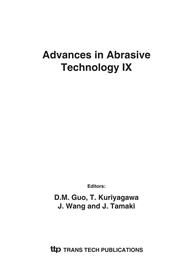p.557
p.565
p.571
p.577
p.583
p.589
p.595
p.601
p.607
Development of Small Radius Ball End Mill for Deep Precision Machining - Feasibility of Highly Accurate Deep Precision Machining with Less Vibration -
Abstract:
The machining of metal dies involves a variety of processes that include grinding, polishing and electrical discharge machining in addition to various cutting processes such as turning, boring, and milling. The precise machining of complex dies, particularly in deep machining, has largely been done by electrical discharge machining in the past, because the use of end mills and other cutting tools for such work has been difficult. In recent years, however, problems such as low machining efficiency and the creation of an affected layer have made the use of end mill cutting tools the general approach to this task. In the research reported here, our objective was to establish guidelines for the optimum design of small radius ball end mills for the deep machining of dies by systematic investigation of the cutting tool characteristics, which is to say the rotational behavior, cutting resistance, actual rate of depth of cut and machining accuracy of small radius ball end mills. Here, the guidelines obtained for ultra-deep, highly-accurate machining that is applicable to machining programs and is based on quantitative results for amounts of tool wear and tool deflection that obtained using the optimum tool shape reported earlier are presented.
Info:
Periodical:
Pages:
583-588
Citation:
Online since:
January 2007
Authors:
Price:
Сopyright:
© 2007 Trans Tech Publications Ltd. All Rights Reserved
Share:
Citation:


